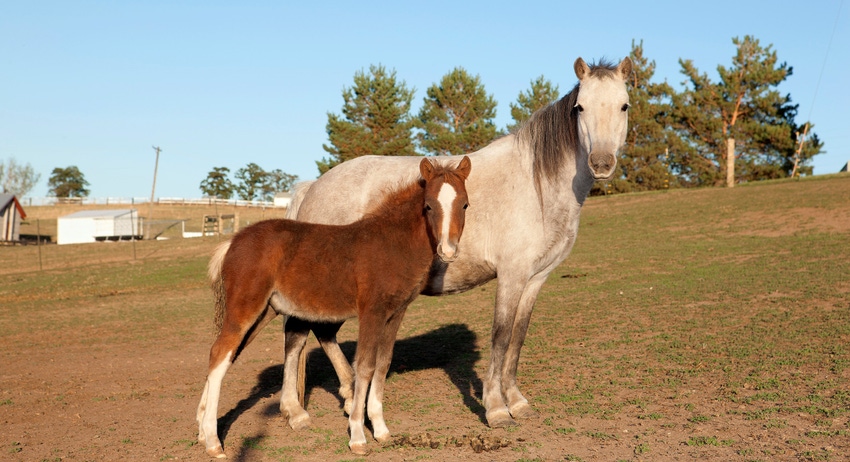March 30, 2022

Scott Schell owns horses and has lived in Wyoming for 59 years. Until he met Jennifer Fernandez, a horse owner in Cody, Schell had never heard of cases of Potomac horse fever (PHF) in Wyoming.
UW Extension recently released an awareness poster, titled “Potomac Horse Fever Is in Wyoming and Adjacent States,” that describes the disease, how it infects horses and what horse owns can do to prevent and/or treat the disease.
“I think that, in the PHF endemic region of the state, people who have had their horses get the disease or had a friend’s horse get it are very aware,” Schell says. “Additionally, many veterinarians in those known PHF areas recommend vaccination for the disease. However, I think many people from other areas of the state aren’t aware of PHF.”
PHF is a warm-season disease of equines. Horses, mules and donkeys contract PHF after accidentally eating adult aquatic insects, such as mayflies and caddisflies, infected with a bacterium. The disease begins with mild symptoms, usually one to three weeks after ingestion of the infected insects.
According to the poster, symptoms horse owners should watch for are depression, lack of appetite, watery diarrhea, mild colic (with watery but decreased gut sounds) and laminitis symptoms on all hooves. If a horse is depressed, owners should check the animal for a fever ranging from 102 to 107 degrees.
As PHF progresses, more severe symptoms, such as acute laminitis, can occur and the disease can cause up to 30 percent mortality. Mares that are 100 to 160 days pregnant when infected with PHF may abort at 190 to 250 days in pregnancy after appearing to recover from the disease.
“It is part of good horse management to observe what is normal for your animals and then to watch for the abnormal every time you are around them,” Schell says.
Because PHF is a bacterium, it is treatable with the correct antibiotics, according to the poster. If a PHF infection in a horse is recognized, diagnosed and treated quickly, an animal’s prognosis is greatly improved.
While he admits he is no veterinarian, Schell says, according to the literature he’s read, initiating the intravenous antibiotic treatments before a horse exhibits the extreme diarrhea symptoms of the disease will reduce the probability of a bad outcome.
Protecting equine
Besides vaccinations, a good way to protect equine from becoming infected is to turn off barn lights during summer nights when aquatic insects are flying. This action can help prevent the insects from ending up in water troughs and food mangers, where they could be consumed by horses.
Schell has a number of ideas as to where to release the poster.
“I think any place the horse-owning public may be visiting or spending time waiting at will be a good place for the poster. So, veterinarian offices, feed stores, boarding stables, extension offices, etc.,” he says. “I plan to get some printed; get them to the 4-H horse programs around the state; and have the members ask to post the posters in appropriate places around the state. I think the poster needs to go up in places where it is a known risk for horses; where there are horse owners new to an endemic area; or just visiting there to know what the symptoms are to watch for.”
Schell adds that horse owners from parts of Wyoming where PHF may not be present need to be aware of the symptoms in case the disease is spreading to other river basins. In 2002, PHF was diagnosed in the Big Horn Basin. Before then, the disease was only known to be present in the far southwestern part of the state.
“Hopefully, it doesn’t spread everywhere,” he says. “But we need to determine PHF’s current extent and monitor for expansion.”
PHF is currently known to occur in western Wyoming and adjacent areas of Idaho, Utah and Montana. PHF also occurs in parts of Nebraska and South Dakota.
Schell hopes to develop a project in cooperation with some researchers to look at both the prevalence rate of PHF in the state and where the disease is present or absent. Information on this is important for improving PHF management and providing guidance to both veterinarians and horse owners.
“For example, if we randomly sample horses five years and older that have lived all of their lives in an endemic PHF river valley and find that 95 percent have been previously infected, it will indicate that a new horse from a PHF-free area brought there will be probably contract PHF and vaccination to reduce the severity of the disease is a very good idea,” Schell says. “My hope is to involve 4-H members with their horses and make it a ‘citizen science’ project.”
The poster can be found at: https://www.wyoextension.org/publications/Search_Details.php?pubid=2091&pub=B-1375. For more information about the PHF awareness poster, call Schell at (307) 399-9344 or email [email protected].
Source: University of Wyoming Extension, which is solely responsible for the information provided and is wholly owned by the source. Informa Business Media and all its subsidiaries are not responsible for any of the content contained in this information asset.
You May Also Like




